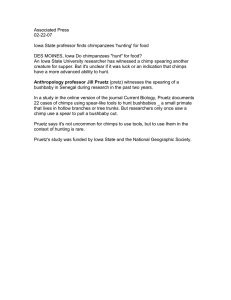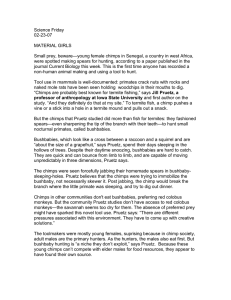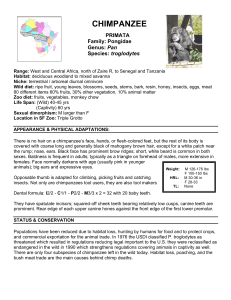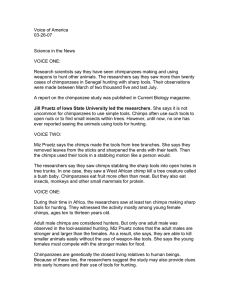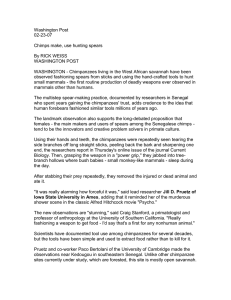New York Times, NY 04-16-07 Almost Human, and Sometimes Smarter
advertisement
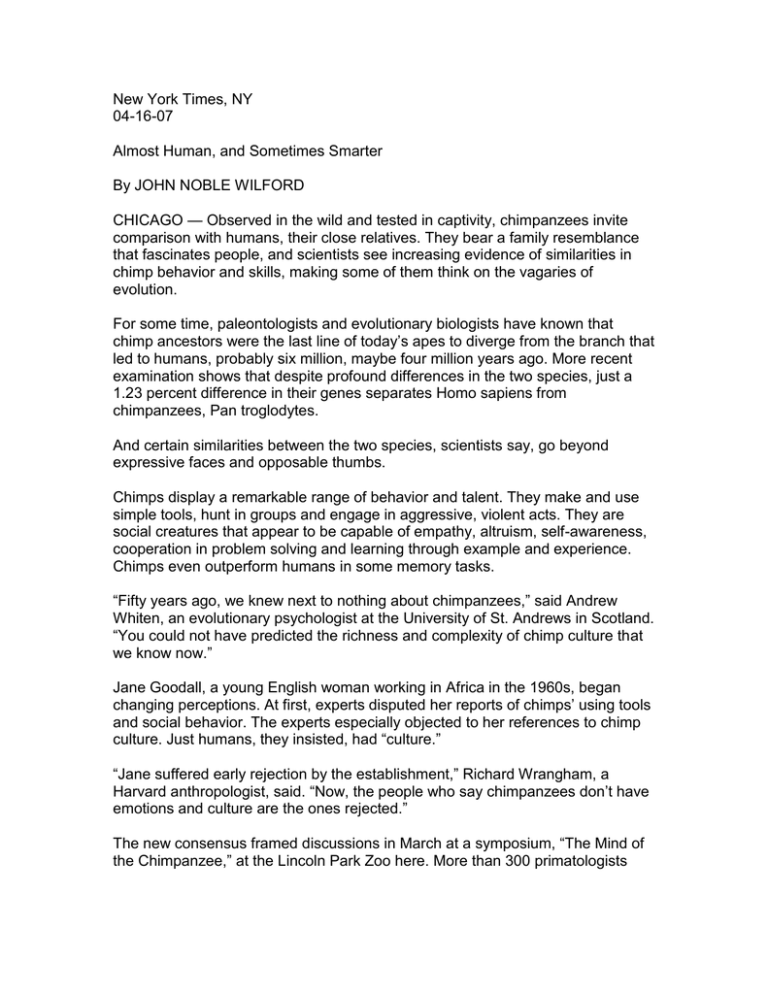
New York Times, NY 04-16-07 Almost Human, and Sometimes Smarter By JOHN NOBLE WILFORD CHICAGO — Observed in the wild and tested in captivity, chimpanzees invite comparison with humans, their close relatives. They bear a family resemblance that fascinates people, and scientists see increasing evidence of similarities in chimp behavior and skills, making some of them think on the vagaries of evolution. For some time, paleontologists and evolutionary biologists have known that chimp ancestors were the last line of today’s apes to diverge from the branch that led to humans, probably six million, maybe four million years ago. More recent examination shows that despite profound differences in the two species, just a 1.23 percent difference in their genes separates Homo sapiens from chimpanzees, Pan troglodytes. And certain similarities between the two species, scientists say, go beyond expressive faces and opposable thumbs. Chimps display a remarkable range of behavior and talent. They make and use simple tools, hunt in groups and engage in aggressive, violent acts. They are social creatures that appear to be capable of empathy, altruism, self-awareness, cooperation in problem solving and learning through example and experience. Chimps even outperform humans in some memory tasks. “Fifty years ago, we knew next to nothing about chimpanzees,” said Andrew Whiten, an evolutionary psychologist at the University of St. Andrews in Scotland. “You could not have predicted the richness and complexity of chimp culture that we know now.” Jane Goodall, a young English woman working in Africa in the 1960s, began changing perceptions. At first, experts disputed her reports of chimps’ using tools and social behavior. The experts especially objected to her references to chimp culture. Just humans, they insisted, had “culture.” “Jane suffered early rejection by the establishment,” Richard Wrangham, a Harvard anthropologist, said. “Now, the people who say chimpanzees don’t have emotions and culture are the ones rejected.” The new consensus framed discussions in March at a symposium, “The Mind of the Chimpanzee,” at the Lincoln Park Zoo here. More than 300 primatologists and other scientists reviewed accumulating knowledge of chimps’ cognitive abilities. After one session, Frans de Waal of Emory University said that as recently as a decade ago there was still no firm consensus on many of the social relationships of chimps. “You don’t hear any debate now,” he said. In his own studies at the Yerkes Primate Research Center at Emory, Dr. de Waal found that chimps as social animals have had to constrain and alter their behavior in various ways, as have humans. It is a part of ape inheritance, he said, and in the case of humans, the basis for morality. The provocative interpretation was advanced in his recent book, “Primates and Philosophers.” Other reports shortly before the symposium had elaborated on the abilities of chimps as toolmakers. Jill Pruetz, a primatologist at Iowa State University, described 22 examples of chimps in Senegal making stick spears to hunt smaller primates for their meat. Dr. Goodall was the first to call attention to chimps as hunting carnivores, not strictly vegetarians. Dr. Pruetz observed several chimps jabbing the spears into hollow tree trunks where bush babies often dwell. Just one attempt was successful. Previously, chimps had been seen using sticks mainly to extract termites from their nests. A team of archaeologists led by Julio Mercader of the University of Calgary reported finding stones in Ivory Coast that chimps used 4,300 years ago to crack nuts. Today’s chimps have often been videotaped using rocks as a hammer to open nuts. The old stones with starch residues from nuts, the researchers said, were the earliest strong evidence of chimp tool use, and the finding suggested that chimps had learned the skill on their own, rather than copying humans. Other researchers combine field work showing chimp behavior in natural habitats with laboratory experiments that are created to disclose their underlying intelligence — what scientists call their “cognitive reserve.” For example, chimps on their own would not sit at a computer responding with rapid touches on the screen as a test of their immediate memory. Videos of their doing just that at Kyoto University in Japan especially impressed the symposium scientists. Tetsuro Matsuzawa, a Kyoto primatologist, described a young chimp watching as numbers 1 through 9 flashed on the computer screen at random positions. Then the numbers disappeared in no more than a second. White squares remained where the numbers had been. The chimp casually but swiftly pressed the squares, calling back the numbers in ascending order — 1, 2, 3, etc.
